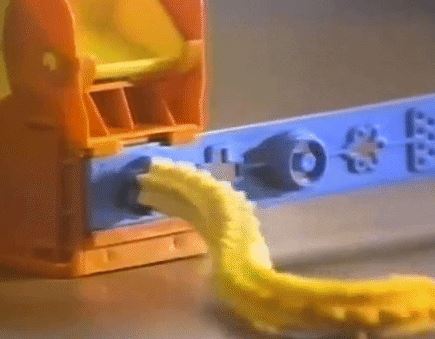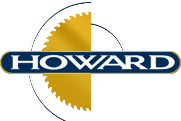Lineal aluminum shapes produced by both direct and indirect aluminum presses are referred to, in general terms, as aluminum extrusions. Understanding the differences between these two types of aluminum extrusion presses may benefit your application. Howard Precision Metals supplies customers with a vast array of aluminum product options, including aluminum extrusions, which are highly suitable for a wide range of applications servicing a large number of industries.

What Are Aluminum Extrusions?
The best way to explain aluminum extrusions and the process by which these products are produces is to simply compare them to a classic toy: PlayDoh®. Believe it or not, this childhood toy perfectly demonstrates the manufacture of extruded aluminum bar products. Instead of PlayDoh®, pre-heated Aluminum billets are pushed through a die with a ram. The die’s shape determines the profile (shape) of the extruded aluminum product. The profile shapes can vary greatly. Our mills can produce extrusions as simple as solid aluminum squares, rectangles, and round bars, and as complex as multi hollow custom shapes with complex geometry and features like screw holes and T-slots.
Factors That Affect Aluminum Extrusion Results
Within any type of extrusion process, various factors must be considered and managed in order to achieve the desired finished product. A change to the process and/or materials used can affect the physical characteristics of the final product. The flexibility available in terms of results attainable for a diverse array of end use applications is the reason the extrusion process is so widely considered.
Some of the manageable factors that can determine the end product results of aluminum extrusions include:
-
Alloy type
-
Die shape
-
Ram speed
-
Billet shape
-
Extrusion ratio
-
Tongue ratio
-
Surface ratio
-
Scrap ratio
-
Temperature
-
Surface finish
-
Tolerance
-
Symmetric design
-
Ability to assemble finished products
Direct Aluminum Extrusion Press
Direct aluminum extrusion presses are the most common extrusion method. In this method, heated aluminum (billet) is placed into a heated walled container. Then, the metal is forced through the die (mold) with the use of a ram. There is an immense amount of pressure in this step of the process. Aluminum extrusion presses can exert anywhere from 100 to 15,000 tons or more! The aluminum press’ capacity for pressure determines how large of a shape it can produce.
Also, there is a dummy block of material placed between the ram and the heated billet during this step. This is done to prevent the two elements, the heated aluminum billet and the ram, from making contact. Because the ram and aluminum billet move forward in the same direction, this method is also commonly referred to as the forward aluminum extrusion process. As the pressure is applied by the ram, the soft aluminum billet is squeezed through the hole of the die. In the manufacture of 6061-T6511 aluminum extrusions, the hot extruded aluminum profiles are then water quenched, stretched and sawn to length. This direct method is the most common method used to produce aluminum extrusions.
Indirect Aluminum Extrusion Press
Also referred to as the backward extrusion method, indirect presses work a bit differently than direct presses. In this method, the container and the billet move together while the die and the ram remain in place. This process is carried out through the use of a stem which must be longer than the container. As a result, the billet is pushed through the die, which remains stationary. This method results in less friction allowing for the heat to be better controlled than in the direct process. Indirect methods generally result in more consistent product quality because the force exerted in the process remains relatively steady. Because of greater temperature consistency from the front to the back of the push in the indirect method, grain structure and mechanical properties tend to be of higher quality. There are size limits to the indirect process and few extruders in North America that even have these capabilities. Hydro aluminum has 2 indirect presses in their Cressona, PA facility that they use to product a range of their Acc-U-Rod® product line or round stock. Following is a link to an article written about the Indirect process from 2012 in Production Machining Magazine. Howard Precision Metals is a proud distributor of Hydro products. If specifically looking for product produced by the indirect process, be sure to request Hydro product by name to verify you will get an extrusion created through an indirect extrusion method.
Types of Profiles Used in Aluminum Extrusion Processes
It is possible to create a wide range of complex aluminum extrusion profiles at various thicknesses. The profiles created can include numerous intricately spaced empty spaces per the required design for the application. These voids in the extruded shape are provided to enable various automation requirements of the design and also comply with certain weight and performance requirements.
At Howard Precision, we offer extruded aluminum shapes in sizes ranging from small to large. Cross-sectional dimensions are used to measure the size of aluminum extrusions. The types of shapes that may be produced through extrusion is innumerable. A common extruded aluminum profile is the hollow beam profile, derived from the square profile. Other types of profiles often created include L-shaped, single radius, and triangular.
Is the Indirect Extrusion Process Better Than the Direct Extrusion Process?
While the process of indirect extrusion is more efficient, it is not without its challenges. This process enables the extrusion of larger sized billets at a faster pace. This method of extrusion also exposes the containers to less wear and tear. Over time, this method produces less die cracking due because there is a reduction of frictional forces and heat formation. With this level of consistency and process control, there are less extrusion defects.
The finished extrusions produced indirectly are also affected by billet surface imperfections to a significant degree. Because the billets are cast without friction, any small particle on the surface of the billet greatly affects the surface finish of the aluminum extrusion. For this reason, chemically cleaning, or scalping the billet of imperfections prior to extrusion process is necessary to remove dirt and oil. The extra step helps to avoid these problems.
However, the indirect extrusion presses are not as versatile as the direct extrusion presses. As stated before, the direct method is the most common one. Because of the simplistic nature of the direct process, more complex shapes are able to be produced. Even though more force is required to produce profile in this method, the range of complexity of the end product is why the direct method is still the go to manufacturing process.
Direct and Indirect Aluminum Extrusion Applications
The extrusion of aluminum is a technology used extensively to create efficient, durable, and high performance shapes in a number of industries. The features of aluminum and aluminum alloys are quite unique and provide distinct advantages over other materials for many applications.
There are few other materials that possess a combination of characteristics such as corrosion resistance, stiffness, strength, lightweight, and that provide the ability to be easily manufactured and fabricated. Therefore, aluminum extrusions developed through the direct and indirect extrusion processes are used in a variety of commercial and industrial applications.
The popularity of aluminum extrusions has no sign of fading soon. The possibilities are numerous when it comes to the ways in which extruded aluminum alloys can be applied to applications in a wide range of industries.
The various industries that make use of direct and indirect aluminum extrusions include:
-
Building and construction (windows, doors, curtain walls, greenhouse structures, home décor
-
Machinery and machine tools (laboratory tables, working tables, production lines,
-
Industrial (carts, inspection tables, workbenches, machine guards)
-
Transportation (parts for cars, buses, trailers, trains)
-
Electrical (thermal solutions, electronic enclosures)
-
Energy (oil and gas, wind, solar)
Trust the Team at Howard Precision Metals with your Aluminum Needs
As one of the largest 100% aluminum service centers in the country, Howard Precision Metals knows aluminum. With more high speed aluminum precision saws under one roof than anyone else, we have the capacity to cut all of your aluminum plate and aluminum extrusion jobs, no matter the size. With the aluminum resources, skills, and experience, our team easily serves customers in a range of industries.
Our customer industries include hydraulic, robotic automation, building construction, aerospace, medical, pneumatic, machinery manufacturing, and much, much more. The next time you need aluminum extrusions, aluminum plate or aluminum sheet, let us help. Call us today at 800.444.0311 or submit a request for quote form to find out how Howard Precision Metals can service all of your aluminum requirements.


